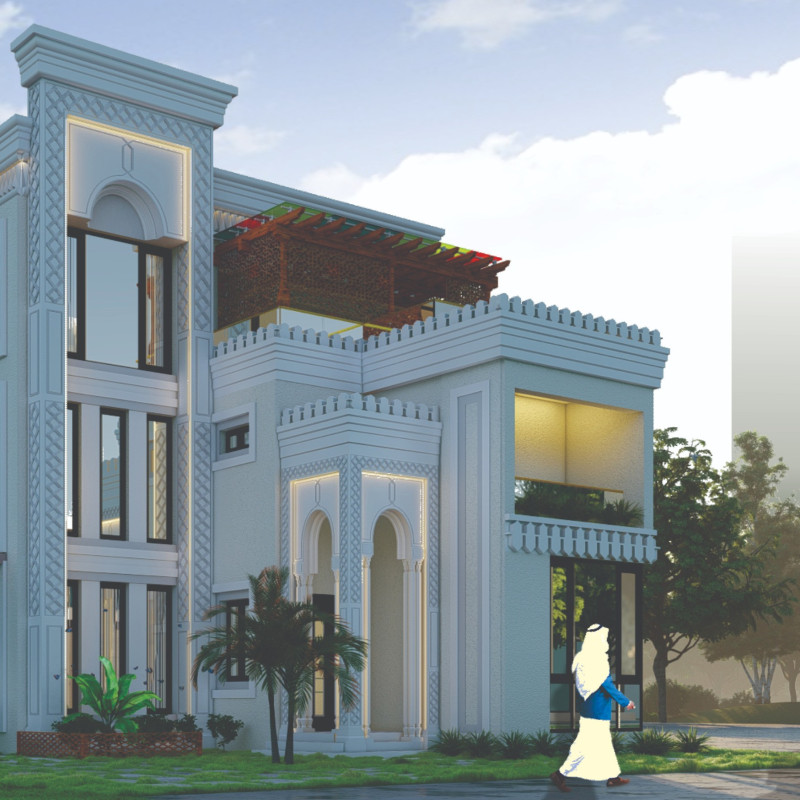5 key facts about this project
From the entryway to the roofline, the design showcases a variety of architectural elements that contribute to both the functionality and visual character of the building. The facade, characterized by a blend of materials such as sustainably sourced wood, polished concrete, and large expanses of glass, creates an inviting atmosphere that encourages interaction. The use of wood not only aligns the structure with natural elements but also provides warmth to the overall aesthetic. Glass is employed extensively, promoting transparency and allowing for natural light to permeate the interior spaces, which enhances the connection between the inside and the outside.
The layout features open-plan spaces that facilitate diverse uses, from collaborative work areas to quiet retreat spaces, reflecting the project’s adaptive nature. The design incorporates movable partitions, enabling easy reconfiguration of the interior environment to suit various needs, making it adaptable for community events or private gatherings. This multifunctionality is a crucial aspect that illustrates the architects' commitment to serving the diverse requirements of its users.
Landscaping plays a significant role in this project. The carefully designed outdoor areas complement the building’s architecture, incorporating native plants that promote biodiversity and reduce maintenance needs. Outdoor seating areas promote relaxation and socialization, further enhancing the community-oriented focus of the project. The relationship between the building and its surroundings has been thoughtfully calibrated, creating a seamless transition between built and natural environments.
A unique aspect of this design is the incorporation of passive solar strategies that inform its environmental sustainability. The orientation of the building was strategically chosen to maximize solar gain while minimizing heat loss, demonstrating an understanding of climate-responsive architecture. Furthermore, rainwater harvesting systems and green roofing strategies integrate ecological considerations into its functionality and aesthetic value.
The architectural design successfully embodies concepts of inclusivity and accessibility, ensuring that all individuals, regardless of their mobility level, can navigate the space effortlessly. Features such as wide entrances, ramps, and appropriately designed restrooms highlight the priority placed on universal design principles. These thoughtful inclusions speak volumes about the architects’ dedication to creating spaces that serve all members of the community.
Lighting design also deserves special mention, as it significantly affects the experience within the building. The architects opted for a combination of ambient and task lighting that harmonizes with natural daylight. This not only enhances the usability of different spaces throughout the day but also influences the overall mood and ambiance.
In terms of aesthetics, the architectural language used in this project reflects a modern vernacular that feels both fresh and timeless. The careful balance of proportions, materiality, and spatial organization culminates in a cohesive design that stands out while remaining respectful to its context. The combination of horizontal and vertical lines, along with varied roof heights, adds dynamic visual interest to the overall silhouette of the structure.
This project stands as a testament to the potential of architecture to foster community engagement and enhance user experience through thoughtful design and planning. By critically addressing both utilitarian needs and aesthetic qualities, the architectural team has crafted a facility that not only meets immediate requirements but also encourages ongoing interaction and connection among its users.
For those interested in a deeper understanding of this remarkable project, exploring the architectural plans, architectural sections, and architectural designs will offer further insights into the innovative ideas and detailed execution that characterize this work. The careful attention to context, materials, and user experience showcases a commitment to responsible architecture that enhances its surroundings while serving the public good.


 Alaba Abiodun Oduniyi,
Alaba Abiodun Oduniyi,  Oladeinde Ebiesuwa,
Oladeinde Ebiesuwa,  Hannah Izuakolam Kanu
Hannah Izuakolam Kanu 






















